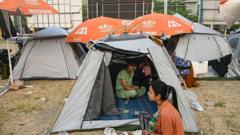Al-Ula, known for its stunning sandstone and granite formations, is on the brink of transformation as Saudi Arabia embraces tourism, prompting concerns about its future as a serene destination.
Transformation of Al-Ula: A Hidden Gem Facing Rapid Change

Transformation of Al-Ula: A Hidden Gem Facing Rapid Change
The once-remote desert landscape of Al-Ula, Saudi Arabia, is experiencing a surge in tourism and development, signaling a shift from untouched nature to commercial hub.
Article Text:
Al-Ula, Saudi Arabia, stands as a testament to nature’s craftsmanship with its striking sandstone and granite formations. However, the once remote beauty of this region is poised for major change in the coming years.
The shift began in 2019, when Saudi Arabia opened its doors to international tourism, welcoming travelers previously restricted to religious pilgrimages. Today, visiting Al-Ula offers a sense of urgency to explore a landscape that is becoming increasingly commercialized, with hotel construction and artistic projects altering the natural ambiance.
Travelers, motivated by the allure of untouched beauty, race to experience Al-Ula before it adopts a more tourist-centric atmosphere akin to that of Petra in Jordan, the iconic archaeological treasure of the Nabateans. Recent reports indicate that within the next decade, tourists may find themselves competing for the perfect photo op and navigating crowded ruins, as the area transforms into a bustling tourist enclave.
Compounding these changes is Saudi Arabia's broader push to reshape its global image, aiming to attract more visitors despite challenges posed by its historical human rights issues and strict cultural regulations. Presently, alcohol remains prohibited, though speculation surrounds potential shifts to attract global events, such as the upcoming 2034 World Cup.
Meanwhile, other regions of Saudi Arabia like Riyadh and Jeddah have already evolved into modern urban centers, with progressive changes including women gaining the right to drive unescorted.
As Al-Ula’s landscape braces for growth, prescient travelers may soon ponder whether they arrived just in time to witness a natural wonder before it transforms into a tourist hotspot.
Al-Ula, Saudi Arabia, stands as a testament to nature’s craftsmanship with its striking sandstone and granite formations. However, the once remote beauty of this region is poised for major change in the coming years.
The shift began in 2019, when Saudi Arabia opened its doors to international tourism, welcoming travelers previously restricted to religious pilgrimages. Today, visiting Al-Ula offers a sense of urgency to explore a landscape that is becoming increasingly commercialized, with hotel construction and artistic projects altering the natural ambiance.
Travelers, motivated by the allure of untouched beauty, race to experience Al-Ula before it adopts a more tourist-centric atmosphere akin to that of Petra in Jordan, the iconic archaeological treasure of the Nabateans. Recent reports indicate that within the next decade, tourists may find themselves competing for the perfect photo op and navigating crowded ruins, as the area transforms into a bustling tourist enclave.
Compounding these changes is Saudi Arabia's broader push to reshape its global image, aiming to attract more visitors despite challenges posed by its historical human rights issues and strict cultural regulations. Presently, alcohol remains prohibited, though speculation surrounds potential shifts to attract global events, such as the upcoming 2034 World Cup.
Meanwhile, other regions of Saudi Arabia like Riyadh and Jeddah have already evolved into modern urban centers, with progressive changes including women gaining the right to drive unescorted.
As Al-Ula’s landscape braces for growth, prescient travelers may soon ponder whether they arrived just in time to witness a natural wonder before it transforms into a tourist hotspot.



















